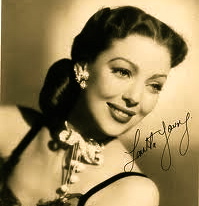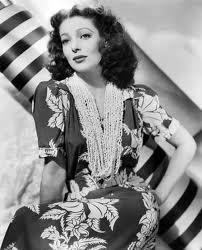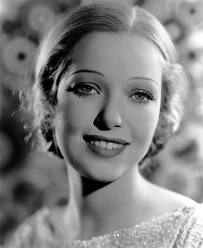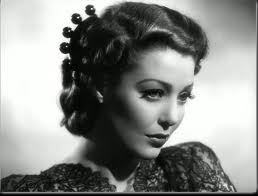Loretta Young

He Stayed for Breakfast -1940 Loretta Young, Melvyn Douglas

Loretta Young (January 6, 1913 – August 12, 2000) was an American actress. Starting as a child actress, she had a long and varied career in film from 1917 to 1953. She won the 1948 best actress Academy Award for her role in the 1947 film The Farmer’s Daughter, and received an Oscar nomination for her role in Come to the Stable, in 1949.
Young then moved to the relatively new medium of television, where she had a dramatic anthology series called The Loretta Young Show, from 1953 to 1961. The series earned three Emmy Awards, and reran successfully on daytime TV and later in syndication. Young, a Catholic, worked with various Catholic charities after her acting career.
Early life
She was born in Salt Lake City, Utah, as Gretchen Young. At confirmation, she took the name Michaela. She and her family moved to Hollywood when she was three years old.
She and her sisters Polly Ann and Elizabeth Jane (screen name Sally Blane) worked as child actresses, but of the three, Loretta was the most successful. Young’s first role was at the age of three, in the silent film The Primrose Ring. The movie’s star Mae Murray so fell in love with Young that she wanted to adopt her. Although her mother declined, Young was allowed to live with Murray for two years. During her high school years, Young was educated at Ramona Convent Secondary School. She was signed to a contract by John McCormick, husband of Colleen Moore, who saw the young girl as having potential. The name “Loretta” was given to her by Colleen, who would later explain that it was the name of her favorite doll.
Career – Film
Young was billed as “Gretchen Young” in the 1917 film, Sirens of the Sea. It was not until 1928 that she was first billed as “Loretta Young” in The Whip Woman. That same year she co-starred with Lon Chaney in the MGM film Laugh, Clown, Laugh. The next year she was anointed one of the WAMPAS Baby Stars.
In 1930, Young, then 17, eloped with 26-year-old actor Grant Withers and married him in Yuma, Arizona. The marriage was annulled the next year, just as their second movie together (appropriately titled Too Young to Marry) was released.
 From the trailer for Cause for Alarm! (1951)
From the trailer for Cause for Alarm! (1951)
During the Second World War, Young made Ladies Courageous (1944; reissued as Fury in the Sky), the fictionalized story of the Women’s Auxiliary Ferrying Squadron. It depicted a unit of female pilots during WWII who flew bomber planes from the factories to their final destinations.
Young made as many as eight movies a year. In 1947, she won an Oscar for her performance in The Farmer’s Daughter. The same year she co-starred with Cary Grant and David Niven in The Bishop’s Wife, a perennial favorite.
In 1949, Young received another Academy Award nomination for Come to the Stable. In 1953, she appeared in her last theatrical film, It Happens Every Thursday, a Universal comedy about a New York couple who move to California to take over a struggling weekly newspaper. Her costar was John Forsythe.
Television
Young hosted and starred in the well-received half-hour anthology series The Loretta Young Show, which ran from 1953 to 1961. Her trademark was an opening dramatic entrance through a door in various high fashion evening gowns. She returned at the program’s conclusion to offer a brief passage from the Bible or a famous quote that reflected upon the evening’s story. (Young’s introductions and conclusions to her television shows were not rerun on television because she legally stipulated that they not be, as she did not want the dresses she wore in those segments to “date” the program.) Her program ran in prime time on NBC for eight years, the longest-running prime-time network program hosted by a woman up to that time.
 The program, which earned her three Emmys, was based on the premise that each drama was in answer to a question asked in her fan mail. The program’s original title was Letter to Loretta. The title was changed to The Loretta Young Show during the first season (as of the February 14, 1954 episode), and the “letter” concept was dropped at the end of the second season. At this time, Young’s hospitalization, due to overwork towards the end of the second season, required that there be a number of guest hosts and guest stars; her first appearance in the 1955–56 season was for the Christmas show. From then on, Young appeared in only about half of each season’s shows as an actress, and served as the program’s host for the remainder. Minus Young’s introductions and conclusions, the series was rerun as the Loretta Young Theatre in daytime by NBC from 1960 to 1964. It also appeared insyndication into the early 1970s, before being withdrawn. In the 1990s, selected episodes from Young’s personal collection, with the opening and closing segments (and original title) intact, were released on home video, and frequently shown on cable television.
The program, which earned her three Emmys, was based on the premise that each drama was in answer to a question asked in her fan mail. The program’s original title was Letter to Loretta. The title was changed to The Loretta Young Show during the first season (as of the February 14, 1954 episode), and the “letter” concept was dropped at the end of the second season. At this time, Young’s hospitalization, due to overwork towards the end of the second season, required that there be a number of guest hosts and guest stars; her first appearance in the 1955–56 season was for the Christmas show. From then on, Young appeared in only about half of each season’s shows as an actress, and served as the program’s host for the remainder. Minus Young’s introductions and conclusions, the series was rerun as the Loretta Young Theatre in daytime by NBC from 1960 to 1964. It also appeared insyndication into the early 1970s, before being withdrawn. In the 1990s, selected episodes from Young’s personal collection, with the opening and closing segments (and original title) intact, were released on home video, and frequently shown on cable television.
In the 1962–1963 television season, Young appeared as Christine Massey, a free-lance magazine writer and mother of seven children, in CBS‘s The New Loretta Young Show. It fared poorly in the ratings on Monday evenings against ABC‘s Ben Casey. It was dropped after one season (26 episodes).
Awards
In 1988, she was awarded the Women in Film Crystal Award for outstanding women who, through their endurance and the excellence of their work, have helped to expand the role of women within the entertainment industry.
Young has two stars on the Hollywood Walk of Fame; one for motion pictures, at 6104 Hollywood Boulevard, and another for television, at 6141 Hollywood Boulevard. In 2011, a Golden Palm Star on the Palm Springs, California, Walk of Stars was dedicated to her.
Personal life
Young in 1938
 Young was married to actor Grant Withers from 1930 to 1931. After that she was involved in affairs with Spencer Tracy and Clark Gable and in 1935 had Gable’s child, a daughter. She married producer Tom Lewis in 1940 and they divorced very bitterly in the mid 1960s. Lewis died in 1988. They had two sons, Peter Lewis (of the legendary San Francisco rock band Moby Grape), and Christopher Lewis, a film director.
Young was married to actor Grant Withers from 1930 to 1931. After that she was involved in affairs with Spencer Tracy and Clark Gable and in 1935 had Gable’s child, a daughter. She married producer Tom Lewis in 1940 and they divorced very bitterly in the mid 1960s. Lewis died in 1988. They had two sons, Peter Lewis (of the legendary San Francisco rock band Moby Grape), and Christopher Lewis, a film director.
She married fashion designer Jean Louis in 1993. Louis died in 1997.
Clark Gable affair
In 1935, Young had an affair with a then-married Clark Gable while on location for The Call of the Wild. During their affair, Young became pregnant. Due to the moral codes placed on the film industry, Young covered up her pregnancy in order to avoid damaging her career (as well as Gable’s). When she began to show she went on a “vacation” to England. Several months later she returned to California. Shortly before the birth she gave an interview from her bed covered in blankets, stating the reason for her long movie absence was because of a condition she had had since childhood.
Loretta Young gave birth to Judith Young on November 6, 1935, in a house she and her mother owned in Venice, California. Three weeks later, she returned to movie-making. After several months of living in the house in Venice, Judy was transferred to St. Elizabeth’s, an orphanage outside Los Angeles. When she was 19 months old, her grandmother picked her up and Young announced to gossip columnist Louella Parsons that she had adopted the infant. The child was raised as “Judy Lewis,” taking the last name of Young’s second husband, producer Tom Lewis.
According to her autobiography Uncommon Knowledge, Judith was made fun of because of the ears she inherited from her father, Clark Gable. She states that, at seven, she had an operation to “pin back” her large ears and that her mother always had her wearing bonnets as a child. Over the years, she had heard rumors that Clark Gable was her biological father as she looked strikingly like him. In 1958, Lewis’ future husband Joseph Tinney told her “everybody” knew that Gable was her biological father. The only time she remembered Gable visiting Lewis was once at her home when she was a teenager; she had no idea he was her biological father. Several years later, he turned up at The Loretta Young Show after Young had been in hospital for several months. Lewis was an assistant and was right behind her mother when she noticed Gable. They never had a relationship and she never saw him again.
Several years later, after becoming a mother herself, Lewis finally confronted her mother. After promptly vomiting, Young admitted Judith’s true parentage, stating that she was “just a walking mortal sin.”
Scandal
 A scandal erupted in 1973, when Young’s son Christopher Lewis, then 29, was charged with child molestation and filming and distributing child pornography, along with 13 other men whom the police labeled a “chicken flick ring.” Lewis and the other men were indicted with soliciting boys ranging from ages 6 to 17 to perform lewd acts in their movies. Despite pleading “no contest” to child molestation and possibly facing up to life in prison, Lewis managed to be let off with probation and a $500 fine.
A scandal erupted in 1973, when Young’s son Christopher Lewis, then 29, was charged with child molestation and filming and distributing child pornography, along with 13 other men whom the police labeled a “chicken flick ring.” Lewis and the other men were indicted with soliciting boys ranging from ages 6 to 17 to perform lewd acts in their movies. Despite pleading “no contest” to child molestation and possibly facing up to life in prison, Lewis managed to be let off with probation and a $500 fine.


